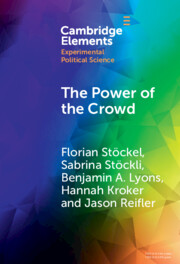Refine search
Actions for selected content:
151 results
Politicians’ misinformation, its correction, and partisanship in Italy
-
- Journal:
- Italian Political Science Review / Rivista Italiana di Scienza Politica , First View
- Published online by Cambridge University Press:
- 16 December 2025, pp. 1-14
-
- Article
-
- You have access
- Open access
- HTML
- Export citation
Blending Truth and Lies: Using an Ethnographic Sensibility to Study Online Misinformation
-
- Journal:
- Perspectives on Politics , First View
- Published online by Cambridge University Press:
- 24 November 2025, pp. 1-15
-
- Article
-
- You have access
- Open access
- HTML
- Export citation
Information Disorder and Global Politics
-
- Journal:
- International Organization / Volume 79 / Issue S1 / December 2025
- Published online by Cambridge University Press:
- 20 November 2025, pp. S26-S43
- Print publication:
- December 2025
-
- Article
-
- You have access
- Open access
- HTML
- Export citation
11 - Disinfodemic Threats. Real, False, and Fake News
- from Introduction to Part II
-
-
- Book:
- Human Rights in the Digital Domain
- Published online:
- 24 October 2025
- Print publication:
- 13 November 2025, pp 199-240
-
- Chapter
-
- You have access
- Open access
- HTML
- Export citation
Emotional language reduces belief in false claims
-
- Journal:
- Judgment and Decision Making / Volume 20 / 2025
- Published online by Cambridge University Press:
- 05 November 2025, e43
-
- Article
-
- You have access
- Open access
- HTML
- Export citation
7 - AI for Human and Misinformation Interactions
-
-
- Book:
- Human-AI Interaction and Collaboration
- Published online:
- 19 September 2025
- Print publication:
- 09 October 2025, pp 153-174
-
- Chapter
- Export citation

The Power of the Crowd
- How the Public Can Both Spoil and Improve Social Media as a Source of Information
-
- Published online:
- 07 October 2025
- Print publication:
- 06 November 2025
-
- Element
-
- You have access
- Open access
- HTML
- Export citation
On the Perils of Engaging
-
- Journal:
- Episteme , First View
- Published online by Cambridge University Press:
- 30 September 2025, pp. 1-20
-
- Article
-
- You have access
- Open access
- HTML
- Export citation
Barriers to Public Health Trust-Building Using Social Media: A Qualitative Analysis
-
- Journal:
- Disaster Medicine and Public Health Preparedness / Volume 19 / 2025
- Published online by Cambridge University Press:
- 26 September 2025, e280
-
- Article
-
- You have access
- Open access
- HTML
- Export citation
1 - The Conservative War
-
- Book:
- Killing the Messenger
- Published online:
- 05 September 2025
- Print publication:
- 25 September 2025, pp 9-25
-
- Chapter
-
- You have access
- Open access
- HTML
- Export citation
3 - Digital Communication and the “Post-Truth” Era
-
- Book:
- Understanding the Language of Virtual Interaction
- Published online:
- 05 September 2025
- Print publication:
- 25 September 2025, pp 27-43
-
- Chapter
- Export citation
2 - The Progressive War
-
- Book:
- Killing the Messenger
- Published online:
- 05 September 2025
- Print publication:
- 25 September 2025, pp 26-50
-
- Chapter
-
- You have access
- Open access
- HTML
- Export citation
Misinformation Among Migrants: Evidence from Mexico and Colombia
-
- Journal:
- Journal of Experimental Political Science , First View
- Published online by Cambridge University Press:
- 01 September 2025, pp. 1-12
-
- Article
-
- You have access
- Open access
- HTML
- Export citation
Information Fragmentation and Global Governance in Hard Times
-
- Journal:
- Ethics & International Affairs / Volume 39 / Issue 2 / Summer 2025
- Published online by Cambridge University Press:
- 22 August 2025, pp. 159-172
-
- Article
-
- You have access
- Open access
- HTML
- Export citation
Chapter 4 - Understanding the Flaws of Experience and Memory
-
- Book:
- Knowledge Doesn't Exist and Other Thoughts on Critical Thinking
- Published online:
- 22 October 2025
- Print publication:
- 21 August 2025, pp 46-62
-
- Chapter
- Export citation
4 - Election-Related Misinformation
-
- Book:
- People v. The Court
- Published online:
- 07 August 2025
- Print publication:
- 21 August 2025, pp 88-112
-
- Chapter
- Export citation
The Religious Roots of Belief in Misinformation: Experimental Evidence from India
-
- Journal:
- British Journal of Political Science / Volume 55 / 2025
- Published online by Cambridge University Press:
- 18 August 2025, e109
-
- Article
-
- You have access
- Open access
- HTML
- Export citation
The new denial: climate solution misinformation on social media
- Part of
-
- Journal:
- Global Sustainability / Volume 8 / 2025
- Published online by Cambridge University Press:
- 04 August 2025, e31
-
- Article
-
- You have access
- Open access
- HTML
- Export citation
8 - Defamation Law and the Crumbling Legitimacy of the Fourth Estate
- from Part III - Evolving Threats to the Press Function
-
-
- Book:
- The Future of Press Freedom
- Published online:
- 25 July 2025
- Print publication:
- 24 July 2025, pp 100-115
-
- Chapter
-
- You have access
- Open access
- HTML
- Export citation
Chapter 7 - Maintenance Messages during a Health Emergency
- from Part II - Communicating during a Health Emergency
-
- Book:
- Risk Communication in Public Health Emergencies
- Published online:
- 05 June 2025
- Print publication:
- 19 June 2025, pp 164-200
-
- Chapter
- Export citation
